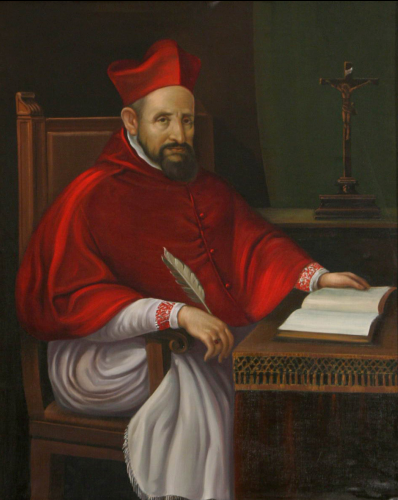“The Mass Of The Foundation Of The Trinitarian Order”.
Artist: Juan Carreño de Miranda.
Illustration: LOUVRE
This Article, by Dr. Marcellino D'Ambrosio,
is taken from, and can be read in full at,
CROSSROADS INITIATIVE
The Title “Doctor of The Church,” unlike the popular Title “Father of The Church,” is an official designation that is bestowed by the Pope in recognition of the outstanding contribution a person has made to the understanding and interpretation of The Sacred Scriptures and the development of Christian Doctrine.
As of 2019, the Official List includes thirty-six men and women who hail from all ages of The Church’s history.
Of these, four are women:
Four of The Ecumenical Fathers, also deemed Doctors of The Church, came from The Eastern (Greek-speaking) Roman Empire:
There are eight other Doctors of The Church from The Patristic Period, making, in total, sixteen Fathers from The Patristic Period who are recognised as Doctors of the Church:
There are eleven Doctors of The Church from The Middle Ages, all of them except the last from The Latin or Western Church:
There are seven Doctors of The Catholic Church who were prominent in the 16th-Century Catholic Reformation, all from The Latin Church:

is taken from, and can be read in full at,
CROSSROADS INITIATIVE
The Title “Doctor of The Church,” unlike the popular Title “Father of The Church,” is an official designation that is bestowed by the Pope in recognition of the outstanding contribution a person has made to the understanding and interpretation of The Sacred Scriptures and the development of Christian Doctrine.
As of 2019, the Official List includes thirty-six men and women who hail from all ages of The Church’s history.
Of these, four are women:
Catherine of Siena;
Teresa of Avila;
Therese of Lisieux;
Hildegard of Bingen.
Those who are not quoted in The Catechism of The Catholic Church are:
Ephræm;
Isidore;
“The Venerable Bede”;
Albert the Great;
Anthony of Padua;
Peter Canisius;
Robert Bellarmine;
John of Avila;
Hildegard of Bingen;
Gregory of Narek;
Lawrence of Brindisi.
There are three requirements that must be fulfilled by a person in order to merit being included in the ranks of the “Doctors of The Catholic Church”:
1. Holiness that is truly outstanding, even among Saints;
2. Depth of Doctrinal Insight;
3. An extensive Body of Writings which The Church can recommend as an expression of the authentic and life-giving Catholic Tradition.
During the era of The Church Fathers, (approximately 100 A.D. - 800 A.D.), eight Doctors of The Church particularly stand out, and are called “Ecumenical Fathers”, because of their widespread influence. Bronze statues of several of these eight are to be found in Saint Peter’s Basilica, Rome.
There are three requirements that must be fulfilled by a person in order to merit being included in the ranks of the “Doctors of The Catholic Church”:
1. Holiness that is truly outstanding, even among Saints;
2. Depth of Doctrinal Insight;
3. An extensive Body of Writings which The Church can recommend as an expression of the authentic and life-giving Catholic Tradition.
During the era of The Church Fathers, (approximately 100 A.D. - 800 A.D.), eight Doctors of The Church particularly stand out, and are called “Ecumenical Fathers”, because of their widespread influence. Bronze statues of several of these eight are to be found in Saint Peter’s Basilica, Rome.
Four of these hailed from The Western (Latin-speaking) half of The Roman Empire.
St. Ambrose
340 A.D. - 397 A.D.
St. Jerome 345 A.D. - 420 A.D.
354 A.D. - 430 A.D.
St. Gregory the Great (Pope)
Four of The Ecumenical Fathers, also deemed Doctors of The Church, came from The Eastern (Greek-speaking) Roman Empire:
295 A.D. - 373 A.D.
330 A.D. - 379 A.D.
330 A.D. - 390 A.D.
306 A.D. - 373 A.D. (Syriac).
315 A.D. - 368 A.D. (Latin).
315 A.D. - 387 A.D. (Greek).
376 A.D. - 444 A.D. (Greek).
St. Leo the Great (Pope)
390 A.D. - 461 A.D. (Latin).
400 A.D. - 450 A.D. (Latin).
St. Isidore of Seville
(last of The Latin Fathers)
560 A.D. - 636 A.D.
(Wikimedia Commons)
(Wikimedia Commons)
(last of the Greek Fathers)
There are eleven Doctors of The Church from The Middle Ages, all of them except the last from The Latin or Western Church:
673 A.D. - 735 A.D.
St. Peter Damian
1007 - 1072.
(Wikimedia Commons)
(Wikimedia Commons)
1033 - 1109.
1090 - 1153.
St. Hildegard of Bingen
1098 - 1179.
(Wikimedia Commons)
(Wikimedia Commons)
1195 - 1231.
St. Albert the Great
1200-1280.
(Wikimedia Commons)
1217-1274.
1225-1274.
1347-1379.
951 A.D. - 1003
(from the Armenian Church).
There are seven Doctors of The Catholic Church who were prominent in the 16th-Century Catholic Reformation, all from The Latin Church:
St. John of Avila
1499-1569.
(Wikimedia Commons)
1515-1582.
St. Peter Canisius
1521-1597.
(Wikimedia Commons)
1542-1591.
(Wikimedia Commons)

St. Robert Bellarmine.
1542-1621.
(Wikimedia Commons)
St. Lawrence of Brindisi.
1559-1619.
(Wikimedia Commons)
1567-1622.
(Wikiquote)
There are two Doctors of The Church in the modern era, both from The Latin Church:
St. Alphonsus Liguori
1696-1787.
(Wikimedia Commons)
1873-1897.
This list and definition of The Doctors of The Church was adapted and updated from that provided by Louis Miller, Beacons of Light: Profiles of Ecclesiastical Writers Cited in the Catechism (Liguori, MO: Liguori, 1995), 61-62.














































